Replacing an Outboard Water Pump
Posted by John Tiger on 3rd Oct 2019
Don't be put off by the fact that you have to drop the lower unit. Here are some tips to get you through it!
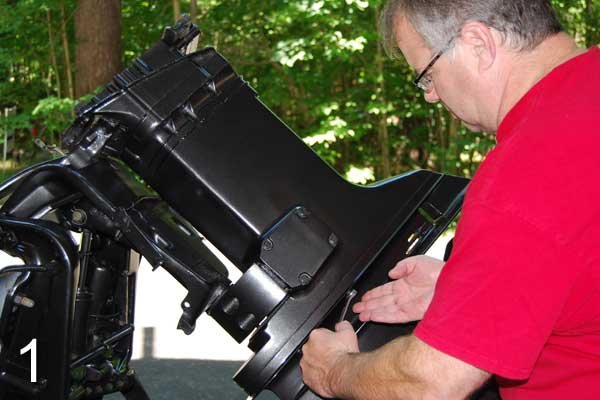
1. Dropping the gearcase to access the water pump requires removal of the mounting bolts.
Outboard water pumps are simple designs. Located just atop the lower gearcase assembly, they're easy to access and service, too. The pump houses a rubber impeller that's keyed to the engine driveshaft. Water enters the lower gearcase through inlets on the sides of the gearcase, just above the propeller shaft area. The driveshaft turns the pump inside a plastic housing with a stainless steel liner. The pump draws water through the intakes and up into the housing. The impeller blades (vanes) touch the liner at lower speeds as the driveshaft turns, but as the engine revs up, the impeller blades bend back away from the housing liner. The pump sends water out of the top of the housing through a brass tube, typically about a half-inch in diameter, up to the engine's powerhead, where it circulates through the system's cooling passages.
Salt, sand, mud, sticks, and other debris take their toll on the pump impeller, housing, and related parts. That's why most outboard technicians recommend replacement every season, or at worst every other season. There are legions of stories that go "I've had my outboard for twenty years and never replaced the water pump"; however, good preventative maintenance practice includes replacement of the pump and housing at regular intervals.
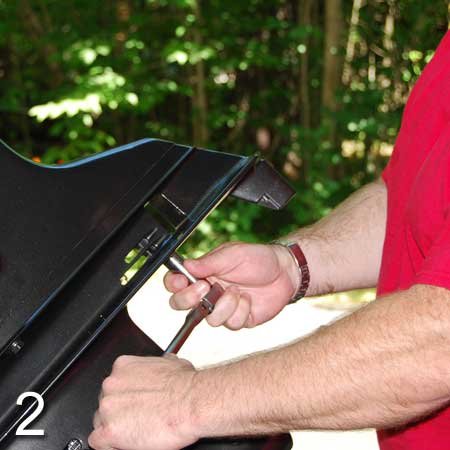
2. Don't forget the bolt located under the trim tab. Mark the position of the trim tab before removing it so you can correctly position it for reinstallation. If you don't, you will have to re-adjust it after water testing the rig, so it will steer neutrally and won't pull to port or starboard.
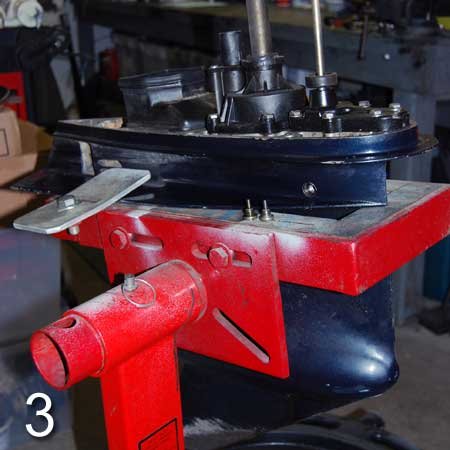
3. Water pump is ready to be removed, using a fitting socket on the four mounting bolts. Notice that the gearcase is also being drained of old lubricant while the author completes the water pump job.
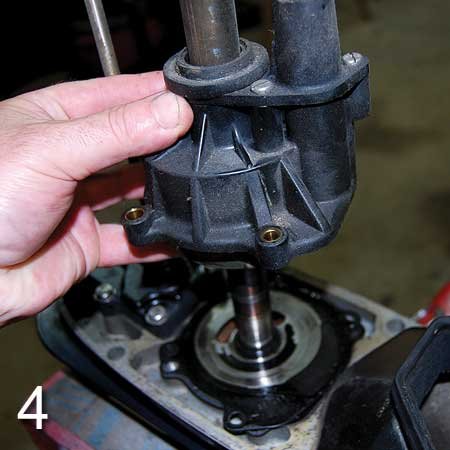
4. Lay out and identify all parts on a clean cloth and then remove the old pump housing and impeller.
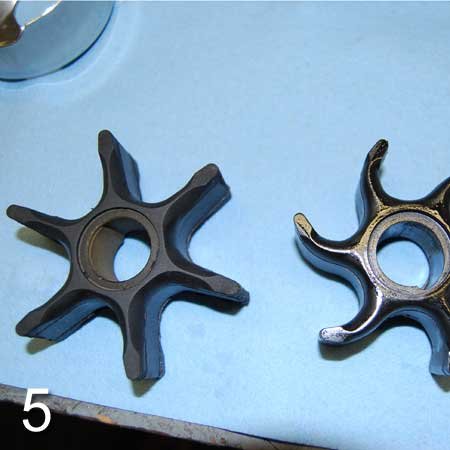
5. Old impeller (on right) blades have taken a set; compare to the new one on the left.
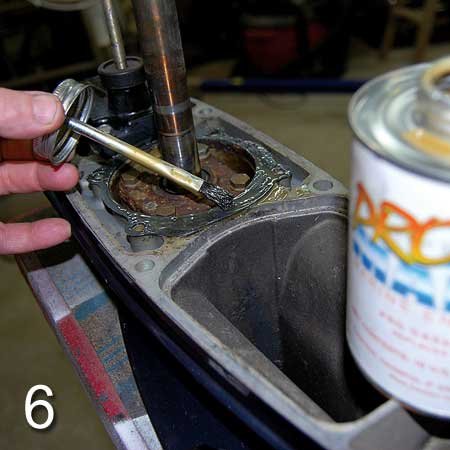
6. Use of proper sealer on gaskets is mandatory to reduce the chance of leaks.
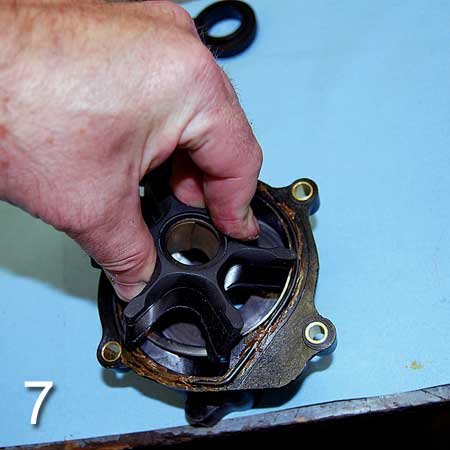
7. The impeller is pushed into the housing liner with a slight clockwise twist.
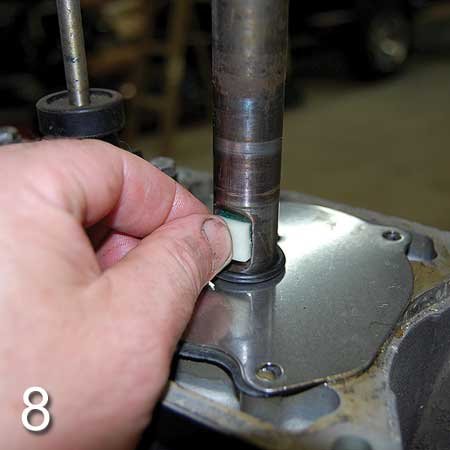
8. Impeller key is placed in the flat on the driveshaft, then the housing and impeller assembly is carefully lowered in place.
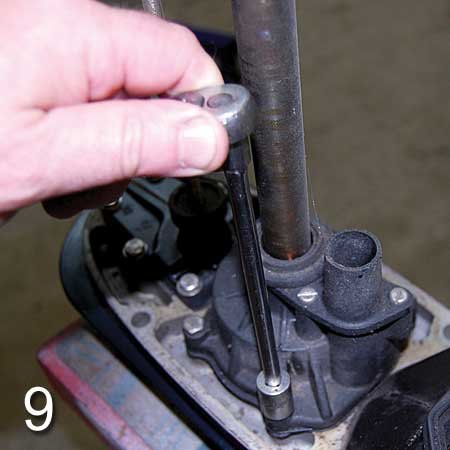
9. Be careful not to overtighten the housing mounting screws.
Buy a factory service manual for your engine, so you can follow the correct procedure and use the correct parts. An hour or so is all it takes to remove the gearcase, replace the pump, and re-install the gearcase on the engine.
The tricky part of the gearcase removal on some outboards is disconnecting the shift shaft. For example, on most Mercurys the engine must be shifted into forward gear first. On many Johnson/Evinrude outboards, the service manual specifically denotes which gear the engine should be in to make removal and re-installation easier. Temporarily removing the shift cable at the engine end will make things much easier as well, especially on engines where the shift shaft disconnection is inside the cowling. The engine should be tilted all the way up for gearcase removal.
Typically there are two attachments per each side of the engine; on some there is also a nut in the front. There are usually at least one or two hidden nuts or bolts up under the anti-ventilation plate (that flat plate just above the propeller). You may have to also remove the trim tab to access one of these attachment bolts. Before you completely remove that last bolt or nut, prepare yourself to catch the gearcase in case it drops right out. Typically this won't happen; it will usually require some wiggling and pulling to remove it, even with all the bolts/nuts out.
Re-installation
Remember that the gearcase must be in the correct gear before installation. Hopefully you didn't move the shift rod at all while servicing the water pump. When reinstalling the unit:
Clean the top of the drive shaft, then dab a small amount of marine grease on the splines — NOT on the top. Greasing the top may prevent the shaft from seating properly inside the crankshaft. Greasing the splines will make removal of the gearcase next time easier.
Be sure the exhaust adapter is properly positioned in the midsection.
While sliding the unit up into the midsection, ensure that the drive shaft, shift shaft, and water tube are positioned properly. Be especially careful that the water tube enters the top of the water pump properly; if it misses, the engine will not receive cooling water and will overheat.
After the installation is complete and you've reconnected the shift shaft and shift cable, start the engine and ensure that it is pumping water, running properly at the proper temperature, and shifting correctly. Consider also servicing the engine's thermostats at this time, so that the entire cooling system is refreshed and ready for service.

